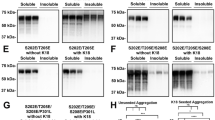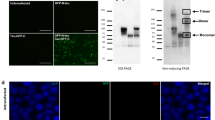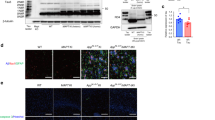Abstract
The microtubule-affinity regulating kinase (MARK) family consists of four highly conserved members that have been implicated in phosphorylation of tau protein, causing formation of neurofibrillary tangles in Alzheimer’s disease (AD). Understanding of roles by individual MARK isoform in phosphorylating tau has been limited due to lack of antibodies selective for each MARK isoform. In this study, we first applied the proximity ligation assay on cells to select antibodies specific for each MARK isoform. In cells, a CagA peptide specifically and significantly inhibited tau phosphorylation at Ser262 mediated by MARK4 but not other MARK isoforms. We then used these antibodies to study expression levels of MARK isoforms and interactions between tau and individual MARK isoforms in postmortem human brains. We found a strong and significant elevation of MARK4 expression and MARK4–tau interactions in AD brains, correlating with the Braak stages of the disease. These results suggest the MARK4–tau interactions are of functional importance in the progression of AD and the results also identify MARK4 as a promising target for AD therapy.






Similar content being viewed by others
References
Augustinack, J. C., Schneider, A., Mandelkow, E. M., & Hyman, B. T. (2002). Specific tau phosphorylation sites correlate with severity of neuronal cytopathology in Alzheimer’s disease. Acta Neuropathologica, 103(1), 26–35.
Biernat, J., Gustke, N., Drewes, G., Mandelkow, E. M., & Mandelkow, E. (1993). Phosphorylation of Ser262 strongly reduces binding of tau to microtubules: Distinction between PHF-like immunoreactivity and microtubule binding. Neuron, 11(1), 153–163.
Braak, H., & Braak, E. (1991). Neuropathological stageing of Alzheimer-related changes. Acta Neuropathologica, 82(4), 239–259.
Chin, J. Y., Knowles, R. B., Schneider, A., Drewes, G., Mandelkow, E. M., & Hyman, B. T. (2000). Microtubule-affinity regulating kinase (MARK) is tightly associated with neurofibrillary tangles in Alzheimer brain: A fluorescence resonance energy transfer study. Journal of Neuropathology and Experimental Neurology, 59(11), 966–971.
Drewes, G. (2004). MARKing tau for tangles and toxicity. Trends in Biochemical Sciences, 29(10), 548–555.
Drewes, G., Ebneth, A., Preuss, U., Mandelkow, E. M., & Mandelkow, E. (1997). MARK, a novel family of protein kinases that phosphorylate microtubule-associated proteins and trigger microtubule disruption. Cell, 89(2), 297–308.
Drewes, G., Trinczek, B., Illenberger, S., Biernat, J., Schmitt-Ulms, G., Meyer, H. E., et al. (1995). Microtubule-associated protein/microtubule affinity-regulating kinase (p110mark). A novel protein kinase that regulates tau–microtubule interactions and dynamic instability by phosphorylation at the Alzheimer-specific site serine 262. Journal of Biological Chemistry, 270(13), 7679–7688.
Gu, G. J., Wu, D., Lund, H., Sunnemark, D., Kvist, A., Milner, R., et al. (2013). Elevated MARK2-dependent phosphorylation of tau in Alzheimer’s disease, analyzed via proximity ligation. Journal of Alzheimers Disease, 33(3), 699–713.
Gustke, N., Steiner, B., Mandelkow, E. M., Biernat, J., Meyer, H. E., Goedert, M., et al. (1992). The Alzheimer-like phosphorylation of tau protein reduces microtubule binding and involves Ser-Pro and Thr-Pro motifs. FEBS Letters, 307(2), 199–205.
Leuchowius, K. J., Jarvius, M., Wickstrom, M., Rickardson, L., Landegren, U., Larsson, R., et al. (2010). High content screening for inhibitors of protein interactions and post-translational modifications in primary cells by proximity ligation. Molecular and Cellular Proteomics, 9(1), 178–183.
Liu, Y., Gu, J., Hagner-McWhirter, A., Sathiyanarayanan, P., Gullberg, M., Soderberg, O., et al. (2011). Western blotting via proximity ligation for high performance protein analysis. Molecular and Cellular Proteomics, 10(11), O111 011031.
Lizcano, J. M., Goransson, O., Toth, R., Deak, M., Morrice, N. A., Boudeau, J., et al. (2004). LKB1 is a master kinase that activates 13 kinases of the AMPK subfamily, including MARK/PAR-1. EMBO Journal, 23(4), 833–843.
Matenia, D., & Mandelkow, E. M. (2009). The tau of MARK: A polarized view of the cytoskeleton. Trends in Biochemical Sciences, 34(7), 332–342.
Mocanu, M. M., Nissen, A., Eckermann, K., Khlistunova, I., Biernat, J., Drexler, D., et al. (2008). The potential for beta-structure in the repeat domain of tau protein determines aggregation, synaptic decay, neuronal loss, and coassembly with endogenous Tau in inducible mouse models of tauopathy. Journal of Neuroscience, 28(3), 737–748.
Moroni, R. F., De Biasi, S., Colapietro, P., Larizza, L., & Beghini, A. (2006). Distinct expression pattern of microtubule-associated protein/microtubule affinity-regulating kinase 4 in differentiated neurons. Neuroscience, 143(1), 83–94.
Nesic, D., Miller, M. C., Quinkert, Z. T., Stein, M., Chait, B. T., & Stebbins, C. E. (2010). Helicobacter pylori CagA inhibits PAR1-MARK family kinases by mimicking host substrates. Nature Structural & Molecular Biology, 17(1), 130–132.
Saadat, I., Higashi, H., Obuse, C., Umeda, M., Murata-Kamiya, N., Saito, Y., et al. (2007). Helicobacter pylori CagA targets PAR1/MARK kinase to disrupt epithelial cell polarity. Nature, 447(7142), 330–333.
Soderberg, O., Gullberg, M., Jarvius, M., Ridderstrale, K., Leuchowius, K. J., Jarvius, J., et al. (2006). Direct observation of individual endogenous protein complexes in situ by proximity ligation. Nature Methods, 3(12), 995–1000.
Trinczek, B., Brajenovic, M., Ebneth, A., & Drewes, G. (2004). MARK4 is a novel microtubule-associated proteins/microtubule affinity-regulating kinase that binds to the cellular microtubule network and to centrosomes. Journal of Biological Chemistry, 279(7), 5915–5923.
Yu, W., Polepalli, J., Wagh, D., Rajadas, J., Malenka, R., & Lu, B. (2012). A critical role for the PAR-1/MARK-tau axis in mediating the toxic effects of Abeta on synapses and dendritic spines. Human Molecular Genetics, 21(6), 1384–1390.
Zieba, A., Pardali, K., Soderberg, O., Lindbom, L., Nystrom, E., Moustakas, A., et al. (2012). Intercellular variation in signaling through the TGF-beta pathway and its relation to cell density and cell cycle phase. Molecular and Cellular Proteomics, 11(7), M111.013482.
Acknowledgments
This work was funded by Uppsala Berzelii Technology Centre for Neurodiagnostics, the Knut and Alice Wallenberg Foundation, the Swedish Research Council for medicine (2007–2720, UL) and by the European Community’s 6th and 7th Framework Programs. We thank the Netherland Brain Bank for postmortem human brains.
Conflict of interest
U.L. is a cofounder of Olink Bioscience that commercializes the in situ PLA technology.
Author information
Authors and Affiliations
Corresponding author
Electronic supplementary material
Below is the link to the electronic supplementary material.
12017_2013_8232_MOESM1_ESM.tif
Figure S1. Schematic illustration of in situ proximity ligation assay. Detection of MARK expression (a) depended upon recognition by a rabbit anti-MARK antibody. Detection of MARK–tau interaction relied on physical proximity between rabbit anti-MARK and mouse anti-tau antibodies (b) and detection of phosphorylation of tau at Ser262 reflected the physical proximity between a mouse anti-tau antibody and a rabbit antibody recognizing pSer262 (c). In all cases (a, b and c), the primary antibodies were bound by species-specific secondary antibodies to which oligonucleotides had been attached. (d) Circularization oligonucleotides could then hybridize to the antibody-linked oligonucleotides, having bound in close proximity, thus allowing the circularization oligonucleotides to be ligated by T4 DNA ligase to form a circular DNA strand. (e) The circular DNA could then be replicated by phi29 polymerase to form a RCA product using one of the antibody-conjugated oligonucleotides as a primer. For cell analysis, fluorophore-labeled oligonucleotides were then allowed to hybridize to the repeated sequence of the RCA products, resulting in brightly fluorescent sub micrometer-sized DNA bundles. For postmortem human brain section, HRP-labeled oligonucleotides were used to detect the repeated sequence of the RCA products, for visualization in brightfield. (TIFF 1523 kb)
12017_2013_8232_MOESM2_ESM.tif
Figure S2. Selectivity of anti-MARK4 antibody (#4834). RhTau 3T3 cells were cotransfected with an expression plasmid encoding GFP and human MARK1, MARK2, MARK3 or MARK4 plasmids. After 24 h culture, in situ PLA experiments were performed. After applying rabbit polyclonal antibodies specific for MARK4 to the MARK- and GFP-expressing cells (green, Transfection control), in situ PLA was performed using a pair of anti-rabbit PLA probes (anti-rabbit PLUS and anti-rabbit MINUS). In situ PLA signals (red) and counter-stained cell nuclei (blue, DAPI) are displayed. Scale bars 20 µm. (TIFF 913 kb)
12017_2013_8232_MOESM3_ESM.tif
Figure S3. Selectivity of anti-MARK1 antibody (AGG6175). RhTau 3T3 cells were transfected with plasmids encoding individual MARK isoforms, along with a GFP plasmid, to investigate the selectivity of different anti-MARK1 antibodies. After applying anti-MARK1 rabbit polyclonal antibodies to the MARK- and GFP-expressing cells (green, Transfection control), in situ PLA was performed using a pair of anti-rabbit PLA probes (anti-rabbit PLUS and anti-rabbit MINUS). In situ PLA signals (red) and counter-stained cell nuclei (blue, DAPI) are displayed. Scale bars 20 µm. (TIFF 1303 kb)
12017_2013_8232_MOESM4_ESM.tif
Figure S4. Selectivity of anti-MARK3 antibody (#9311). RhTau 3T3 cells were transfected with individual MARK plasmids and with a GFP plasmid. After applying anti-MARK3 rabbit polyclonal antibody to the MARK- and GFP-expressing cells (green, Transfection control), in situ PLA was performed using a pair of anti-rabbit PLA probes (anti-rabbit PLUS and anti-rabbit MINUS). In situ PLA signals (red) and counter-stained cell nuclei (blue, DAPI) are displayed. Scale bars 20 µm. (TIFF 2352 kb)
12017_2013_8232_MOESM5_ESM.tif
Figure S5. MARK4–tau interactions in cells expressing MARK4 under treatment with different concentrations of staurosporine. RhTau 3T3 cells were transfected with MARK4 plasmid, and treatments with 0.5, 1 and 5 µM staurosporine were performed to evaluate the toxicity and inhibition of staurosporine on MARK4–tau interactions. Treatment of 0.5 µM staurosporine significantly inhibited MARK4–tau interactions, and the effect of inhibition was dose dependent. Data for the plot were collected from two independent experiments. Open circles represent statistical outliers in analyzed data. (TIFF 128 kb)
12017_2013_8232_MOESM6_ESM.tif
Figure S6. Expression level of MARK4 in transfected rhTau 3T3 cells with or without treatment with the CagA peptide. In situ PLA was performed to detect expression level of MARK4 (red) after treatment with (CagA peptide (+)) or without CagA peptide (CagA peptide (-)) in GFP- (Transfection control) and MARK4-expressing cells (yellow, merged). Cell nuclei were counterstained with DAPI (blue). Scale bars 20 µm. (TIFF 498 kb)
12017_2013_8232_MOESM7_ESM.tif
Figure S7. Validation of in situ PLA signals in transfected rhTau 3T3 cells. In a technical control experiment for validation of the signals for MARK4–tau interaction and phosphorylation of tau at Ser262 in MARK4-transfected cells–as shown in Figure 2–only primary mouse antibodies specific for human tau was present. Due to the omission of primary rabbit antibodies against pSer262 or primary rabbit antibodies against MARK, no signal was observed (b), in comparison with detection using the pair of primary antibodies (rabbit anti- MARK4 antibodies and mouse anti-tau antibodies, a). Scale bar 20 µm. (TIFF 799 kb)
12017_2013_8232_MOESM8_ESM.tif
Figure S8. Upregulated expression levels of MARK4 in the CA4-CA3 field of AD brains. In the CA4-CA3 field, expression levels of MARK1 (a), MARK2 (b) and MARK3 (c) were similar in AD brain sections and in sections from NDE cases. The expression levels of MARK4 in AD were significantly increased compared to those in NDE cases (d, p = 0.04) and correlated with Braak stages of the brain samples with a R2 value of 0.28 (e, p = 0.04). AD cases and NDE cases are represented as gray filled triangles and open triangles, respectively. Average PLA signal of each data point in the plot was generated from more than 400 neurons in each brain sample. N.S. represents statistically non-significant. (TIFF 1105 kb)
12017_2013_8232_MOESM9_ESM.tif
Figure S9. Interactions between tau and MARK4 were elevated in the CA4–CA3 field of AD brains. In the CA4–CA3 field, interactions between tau and individual MARK1-3 (a, b and c) were similar in AD brain sections and in sections from NDE cases. Significant increases were observed for MARK4–tau interactions (d, p = 0.001) compared to that in NDE cases. MARK4–tau interactions correlated with Braak stages of the brain samples in CA4-CA3 field (e, R2 = 0.66, p = 2 × 10-4). AD cases and NDE cases are represented as gray filled circles and open circles, respectively. Average PLA signal of each data point in the plot was generated from more than 400 neurons in each brain sample. N.S. represents statistically non-significant. (TIFF 1110 kb)
Rights and permissions
About this article
Cite this article
Gu, G.J., Lund, H., Wu, D. et al. Role of Individual MARK Isoforms in Phosphorylation of Tau at Ser262 in Alzheimer’s Disease. Neuromol Med 15, 458–469 (2013). https://doi.org/10.1007/s12017-013-8232-3
Received:
Accepted:
Published:
Issue Date:
DOI: https://doi.org/10.1007/s12017-013-8232-3




